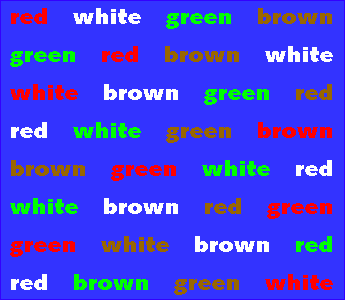Brain exercise: Better than coffee
September 14, 2006//
|
Quick! say aloud what color you see in every word below, NOT the word you read :-) The Stroop test is used in neuropsychological evaluations to measure mental vitality and flexibility, since performing well requires strong inhibition capability. |

Posted in Brain Teasers, Brain/ Mental Health
10 Comments
About SharpBrains
SHARPBRAINS is an independent think-tank and consulting firm providing services at the frontier of applied neuroscience, health, leadership and innovation.
SHARPBRAINS es un think-tank y consultoría independiente proporcionando servicios para la neurociencia aplicada, salud, liderazgo e innovación.



This is tricky–and fun! Thanks for the mental calisthenics!
–Maria
Ha! I really slowed down when the color and word no longer coincided. Association is a strong predicter of response!
Answer: Brown
Happy that you enjoyed it!
The trick of these is dissociating from the text itself. A slight relaxation of the pupils and the text becomes blurred allowing one to focus only on the color.
Aaron: great trick. You can certainly do that. Alternatively, you can train your brain to inhibit your natural response and instead develop a new response pattern.
its hard
blue color , its all filled inside all the letters of the words given .
Shasha: a very creative, and technically correct, answer :-) Now, can you also say the color of each word?
That’s hard at first…but when I group the words by color (all reds, all greens, etc) and then jump around to that color it becomes very easy. I think that might be cheating. (I like shashank’s answer too)